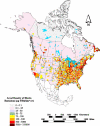Advances in analytical techniques for polychlorinated dibenzo-p-dioxins, polychlorinated dibenzofurans and dioxin-like PCBs
- PMID: 16794816
- PMCID: PMC1764597
- DOI: 10.1007/s00216-006-0479-1
Advances in analytical techniques for polychlorinated dibenzo-p-dioxins, polychlorinated dibenzofurans and dioxin-like PCBs
Abstract
Analytical techniques for the determination of polychorinated dibenzo-p-dioxins (PCDD), polychlorinated dibenzofurans (PCDF) and dioxin-like PCBs (DLPCB) are reviewed. The focus of the review is on recent advances in methodology and analytical procedures. The paper also reviews toxicology, the development of toxic equivalent factors (TEF) and the determination of toxic equivalent quantity (TEQ) values. Sources, occurrence and temporal trends of PCDD/PCDF are summarized to provide examples of levels and concentration ranges for the methods and techniques reviewed.
Figures


Similar articles
-
Estimation and characterization of PCDD/Fs and dioxin-like PCB emission from secondary zinc and lead metallurgies in China.J Environ Monit. 2009 Apr;11(4):867-72. doi: 10.1039/b818555g. Epub 2009 Feb 6. J Environ Monit. 2009. PMID: 19557242
-
Levels and trends of polychlorinated dibenzo-p-dioxins/furans (PCDD/Fs) and dioxin-like polychlorinated biphenyls (PCBs) in Spanish commercial fish and shellfish products, 1995-2003.J Agric Food Chem. 2005 Oct 19;53(21):8406-13. doi: 10.1021/jf050835z. J Agric Food Chem. 2005. PMID: 16218694
-
Polychlorinated dioxins, furans (PCDD/Fs), dioxin-like polychlorinated biphenyls (dl-PCBs) and indicator PCBs (ind-PCBs) in egg and egg products in Turkey.Chemosphere. 2014 Jan;94:13-9. doi: 10.1016/j.chemosphere.2013.08.056. Epub 2013 Sep 19. Chemosphere. 2014. PMID: 24055026
-
Dioxin formation from waste incineration.Rev Environ Contam Toxicol. 2007;190:1-41. doi: 10.1007/978-0-387-36903-7_1. Rev Environ Contam Toxicol. 2007. PMID: 17432330 Review.
-
Monitoring polychlorinated dibenzo-p-dioxins/dibenzofurans and dioxin-like polychlorinated biphenyls in Africa since the implementation of the Stockholm Convention-an overview.Environ Sci Pollut Res Int. 2019 Jan;26(1):101-113. doi: 10.1007/s11356-018-3629-z. Epub 2018 Nov 9. Environ Sci Pollut Res Int. 2019. PMID: 30414030 Review.
Cited by
-
Emerging persistent organic pollutants in Chinese Bohai Sea and its coastal regions.ScientificWorldJournal. 2014 Feb 3;2014:608231. doi: 10.1155/2014/608231. eCollection 2014. ScientificWorldJournal. 2014. PMID: 24688410 Free PMC article. Review.
-
Human biological monitoring of suspected endocrine-disrupting compounds.Asian J Androl. 2014 Jan-Feb;16(1):5-16. doi: 10.4103/1008-682X.122197. Asian J Androl. 2014. PMID: 24369128 Free PMC article. Review.
-
The need and potential of biosensors to detect dioxins and dioxin-like polychlorinated biphenyls along the milk, eggs and meat food chain.Sensors (Basel). 2011;11(12):11692-716. doi: 10.3390/s111211692. Epub 2011 Dec 15. Sensors (Basel). 2011. PMID: 22247688 Free PMC article. Review.
-
Analytical methods for PCBs and organochlorine pesticides in environmental monitoring and surveillance: a critical appraisal.Anal Bioanal Chem. 2006 Oct;386(4):769-89. doi: 10.1007/s00216-006-0765-y. Epub 2006 Sep 20. Anal Bioanal Chem. 2006. PMID: 17047943 Free PMC article.
-
Ultrasensitive surface-enhanced Raman scattering detection in common fluids.Proc Natl Acad Sci U S A. 2016 Jan 12;113(2):268-73. doi: 10.1073/pnas.1518980113. Epub 2015 Dec 30. Proc Natl Acad Sci U S A. 2016. PMID: 26719413 Free PMC article.
References
-
- None
- Clement RE, Koester CJ, Grey L (1994) In: Kiceniuk JW, Ray S (eds) Analysis of contaminants in edible aquatic resources. VCH, New York, Ch 4, pp 347–377
-
- {'text': '', 'ref_index': 1, 'ids': [{'type': 'DOI', 'value': '10.1021/ac00012a012', 'is_inner': False, 'url': 'https://doi.org/10.1021/ac00012a012'}, {'type': 'PubMed', 'value': '1767936', 'is_inner': True, 'url': 'https://pubmed.ncbi.nlm.nih.gov/1767936/'}]}
- Clement RE (1991) Anal Chem 63:1130A–1139A - PubMed
-
- None
- Clement RE, Tosine HM (1989) In: Afghan BK, Chau ASY (eds) Analysis of trace organics in the aquatic environment. CRC, Boca Raton, FL, Ch 5, pp 151–204
-
- {'text': '', 'ref_index': 1, 'ids': [{'type': 'DOI', 'value': '10.1002/mas.1280070603', 'is_inner': False, 'url': 'https://doi.org/10.1002/mas.1280070603'}]}
- Clement RE, Tosine HM (1988) Mass Spec Rev 7:593–636
-
- {'text': '', 'ref_index': 1, 'ids': [{'type': 'DOI', 'value': '10.1016/S0021-9673(01)95990-4', 'is_inner': False, 'url': 'https://doi.org/10.1016/s0021-9673(01)95990-4'}]}
- Ryan JJ, Conacher HBS, Panapio LG, Lau BPY, Hardy JA, Masuda Y (1991) J Chromatogr 541:131–183
Publication types
MeSH terms
Substances
LinkOut - more resources
Full Text Sources

